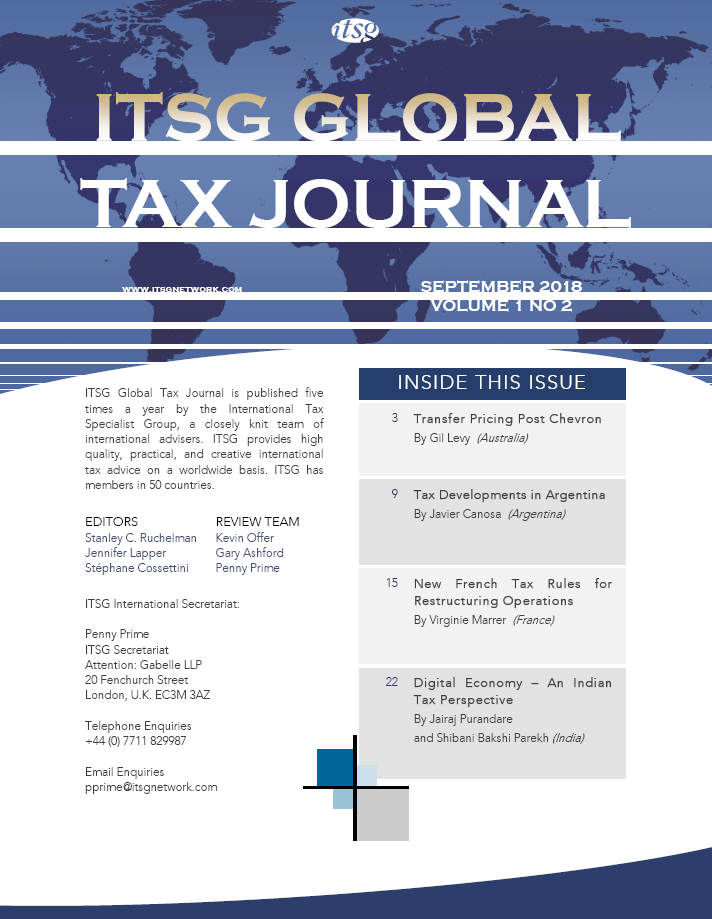Transfer pricing issues give rise to problems for corporate management and their tax advisers, particularly when there are controlled entities in multiple countries with different reporting currencies. These issues also raise problems for courts having to determine the proper price denominated in the proper currency in often-intricate fact settings. This article summarises the recent judgement on appeal to the Full Federal Court of Australia in Chevron Australia Holdings Pty Ltd (C.A.H.P.L.) v. Commissioner of Taxation (C of T) (2017) FCAFC 62. This is a landmark case in Australia that may have global implications for multi-national companies with respect to internal financing arrangements.
Background
In 2003, C.A.H.P.L., an Australian-resident corporation, and Chevron Texas Funding Corporation (C.T.F.C.), a U.S. subsidiary of C.A.H.P.L., entered into a “Credit Facility Agreement” (the Agreement). Pursuant to the Agreement, C.A.H.P.L. borrowed the Australian dollar equivalent of approximately U.S. $2.5 billion from C.T.F.C. Interest was paid by C.A.H.P.L. to C.T.F.C. at about 9% per annum, which was commensurate with the commercial rates typically charged on unsecured loans. No security was posted by C.A.H.P.L., and no guarantee was provided by the ultimate holding company, Chevron Corporation.
C.T.F.C. raised its money through the issuance of U.S. dollar denominated commercial paper. The commercial paper issued by C.T.F.C. bore interest at the rate of 1.2%. The obligation of C.T.F.C. was supported by a guarantee of Chevron Corporation.
The borrowed funds were used by C.A.H.P.L. for an internal refinancing of an Australian dollar denominated debt of Chevron Australia Pty Ltd and the funding C.A.H.P.L.’s acquisition of Texaco Australia Pty Ltd.
In each of the relevant income years, C.A.H.P.L. claimed tax deductions for interest paid to C.T.F.C., thus transforming non-assessable dividends into non-exempt income pursuant to an exemption for foreign non-portfolio dividends1. The result from an Australian tax viewpoint was the creation of untaxed dividends received by C.T.F.C. that offset interest payments in C.A.H.P.L.’s hands. At the same time, C.T.F.C. made significant profits from borrowing at a rate of 1.2% and lending at a rate of 9%, which would not be taxed in Australia. Testimony at trial indicated that the interest payments were not taxed in the U.S.
The Commissioner issued amended assessments to C.A.H.P.L. for the relevant years primarily under Division 13 of the 1936 Act, which broadly provides that the Commissioner may substitute an amount that he determines to be arm’s length for consideration paid by an Australian tax resident where (i) property is acquired under an international agreement, (ii) the Commissioner is satisfied that the parties have not dealt with each other at arm’s length in relation to the property acquired under the agreement, and (iii) the consideration given for the property exceeds the amount that would be paid in an arm’s length transaction. Further determinations with respect to some of the years were made under section 815-15 of the Income Tax Assessment Act 1997(the 1997 Act)2.
Observations
- The determination of arm’s length should be undertaken in a holistic manner.
Chevron argued that Division 13 required an analysis of the actual agreement, i.e. an unsecured loan with no covenants, the only flexibility being the interest rate if such an agreement had been entered into between parties acting at arm’s length.
The Court held that such a narrow interpretation of the provisions meant that such approach would omit the normal security and operational covenants that would normally be required if the parties were dealing with each other at arm’s length. Such terms and conditions were effectively missing in the loan documentation.
Accordingly, it is now important that when undertaking a transfer pricing analysis, all terms and conditions contained in an agreement that may impact the price should be incorporated into the transfer pricing analysis on an arm’s length basis. In this case, the relevance is that arm’s length parties would not enter into an agreement to advance U.S. $2.5 billion unsecured with no covenants.
- The arm’s length hypothetical should remain as close to the actual agreement as possible
In other words, the actual agreement should be respected as much as possible with exception to unrealistic terms, which should be disregarded or substituted.
The Court considered arm’s length conditions such as security and covenants to be missing for the purpose of pricing the arm’s length interest rate for the Agreement. However, the five-year tenor and Australian currency of the Agreement were not modified.
- Taxpayers should not be considered as orphans
Importantly, the Court predicated that in undertaking a transfer pricing analysis, a taxpayer should be considered in its capacity as a member of a multinational group and not on a stand-alone basis.
Accordingly, the value of any parental affiliation should be taken into account when looking at intragroup loans.
For example, it is possible that support from the parent may be a factor when looking at security.
- “Internal” pricing references remain the preferred approach of the courts
In this case, the Court has remained consistent with the established approach of using “internal pricing references” as a reference. That is, they referred to a prior third-party transaction that was entered into by another member of the same international group. In this case, it was the debt funding sourced by C.T.F.C. from the commercial paper market.
In FC of T v. SNF (Australia) Pty Ltd (2011) Australian Tax Cases (A.T.C.) 20-265 (as published by C.C.H.), which dealt with the purchase of trading stock by an Australian taxpayer from international related parties, the Australian court relied on pricing relating to the sale of similar stock by the parent to third parties. In Roche Products Pty ltd v. FC of T (2008) A.T.C. 10-036, references were also made to the predicted margins that would be made for sales to relevant third parties by the global group.
The Australian Taxation Office (A.T.O.) has since indicated, with respect to intragroup debt arrangements, that third-party debt arrangements entered into by the ultimate parent, or the group’s consolidated cost of debt, will be a relevant factor for risk assessment purposes.
From an international perspective, where there is a requirement to consider the O.E.C.D.’s five factors of comparability when determining arm’s length conditions, internal pricing references may be the best starting point to make reasonable and reliable adjustments to arrive at appropriate transfer prices. In this regard, comparability factors such as economic circumstances, business strategies of the parties, its functions, assets, and risks of the parties may be relatively strong internal pricing references depending on the availability of other evidence. The question is whether internal pricing references provide strong evidence of arm’s length conditions.
- Appropriate evidence is critical
With the reverse onus of proof lying with the taxpayer as it applies in Australia, taxpayers must now go beyond merely pricing the terms and conditions of an agreement as it stands, and “step back” to make sure the agreement makes commercial sense overall with reference to all the relevant factors.
For example, the Court placed little weight on evidence put forward by certain Chevron experts that the pricing of the Agreement was not unreasonable given it was accepted by these experts that the Agreement, as constructed, would not have been entered into by a single lender or a group of lenders without financial covenants.
Outstanding Questions
Notwithstanding the guidance given by the Court in this case, there are a number of important questions which remain open.
- What is the degree of evidence required to satisfy the onus of proof?
The Court was clear that they considered the Agreement could not be entered into without securities or financial covenants. However, the Court also accepted Chevron’s submission that the hypothetical agreement might reasonably have been expected to be in Australian currency on the basis that this would limit foreign exchange gains or losses despite a large portion of C.A.H.P.L.’s revenues being denominated in U.S. dollars.
Depending on the facts and evidence available, this would imply that the determination of a particular term or condition as commercial may not necessarily require “external” market data to support the position taken. Rather, contemporaneous internal documents, such as treasury policies, which the Court considered in reaching its decision, may provide useful evidence.
In any event, a degree of judgement may be required regarding the extent of evidence required to support a condition as commercial, particularly given taxpayers will inevitably have fewer resources available to them to make such decisions for standard tax compliance purposes relative to the resources and evidence available to the A.T.O. when intragroup arrangements are scrutinised at a later point in time.
- Can guarantee fees and/or other relevant financing costs form part of the arm’s length conditions?
The Court made it clear that there are likely instances where arm’s length payments could have been given by independent parties and could be factored in the determination of arm’s length conditions, regardless of whether such payments were actually made.
Justice Pagone used the example of a guarantee fee that may be charged by Chevron Corporation to C.A.H.P.L. for obtaining access to a cheaper interest rate. However, this was not explored further, as no evidence was provided with respect to this example. Nonetheless, there is a question as to whether independent parties would have provided a guarantee under similar facts and circumstances. The value of such a guarantee and the degree of evidence required to satisfy the onus of proof remain open as a matter of law but are frequently taken into account by transfer pricing economists.
A similar question arises for other arm’s length terms that could be expected in independent loan arrangements. Breakup costs, penalty payments, and upfront fees can all form parts of third-party debt agreements and may, based on the available evidence, be relevant for determining the arm’s length conditions which apply to an intragroup loan.
- Is the parent’s cost of fund always the right reference point?
In Chevron, the A.T.O. calculated amended assessments with reference to the interest rate that applied to the commercial paper that was borrowed by C.T.F.C. This commercial paper was guaranteed by the Chevron Corporation, the ultimate parent of the group. Although the A.T.O. was successful in this case and has since confirmed its expectation that in most cases, intragroup debt should be aligned to the ultimate parent’s external cost of debt. There are possible instances where, based on available evidence, an alternative reference point should be considered notwithstanding the fact that the taxpayer is a member of a multinational group. For example, the use of a parent’s cost of funds may be inappropriate where that parent is the head of a sovereign wealth or pension fund, as a number of these funds may ‘ring-fence’ their underlying operations from the remainder of the group or may not source external debt for funding purposes.
- Which Currency?
The currency in which an international related-party dealing is denominated is a relevant transfer pricing consideration. In Chevron, it was the Commissioner’s contention that if the Agreement had been between independent parties dealing at arm’s length, C.A.H.P.L. would have borrowed in U.S. dollars and incurred a liability to pay interest and repay principal in U.S. dollars.
Both sides produced a high volume of evidence to support their competing contentions as to the appropriate currency in which to undertake the transfer pricing analysis. There were various arguments or positions put forward, but perhaps it is best to start with the facts:
- For the year which ended 31 December 2003, 88% of the Chevron Australia Consolidated Group revenues, which were derived from the sale of crude oil and L.N.G., were denominated in U.S. dollars with the remaining 12% denominated in Australian dollars.
- For the same period, approximately 97% of expenses of that group were incurred in Australian dollars, which presumably includes interest paid on both the subject related-party borrowing and also the debt that it replaced. The remaining expenses were incurred in U.S. dollars (1%) and other currencies (2%).
- The currency of the existing borrowings that were being refinanced by the Agreement was denominated in Australian dollars.
- The financial reports for the Australian group were prepared with an Australian dollar functional currency. In the author’s view, this factual scenario, which involved predominantly U.S. dollar denominated revenues but Australian dollar denominated expenses, makes the determination of the natural functional currency of the Chevron Australia Consolidated Group the product of a finely balanced analysis. Without wanting to re-examine the accounting or tax ideals of functional currency, the reporting currency was the Australian dollar. However, it is worth setting out a number of factors that were argued or put into evidence in the case on the point of currency. These can be loosely grouped into three categories.
- The nominal outcome. Some evidence suggested that U.S. dollar was the more appropriate currency for the loan simply because, at the time, the interest rates for U.S. denominated dollar borrowings were lower than the interest rates for Australian dollar borrowings. However, this is a somewhat overly simplistic analysis without consideration for the additional factors that follow.
- The accounting outcome. Various evidence was provided on the “accounting” impact of the currency of the borrowing. A U.S. dollar denominated borrowing would have resulted in profit and loss volatility (in the form of foreign currency gains and losses) being recognized as the U.S. dollar denominated liability; thus, it would be restated using the prevailing Australian dollar/U.S. dollar exchange rate at each balance date. There was no evidence that there were significant U.S. dollar denominated accounting assets on the balance sheet that were required to be restated in the same way. Accordingly, there was not a “natural” accounting hedge in the local accounts if the Agreement was denominated in U.S. dollars. This potential accounting volatility had a number of consequences, which include (i) the ability of the Australian group to pay dividends in the event of adverse unrealized F.X. losses being incurred and (ii) the adverse impact on the thin capitalisation position of the group, given that the thin capitalisation provisions use accounting numbers as the basis for the calculation of safe-harbour debt amounts.
It is also worth considering the group’s position at the consolidated accounting level. The evidence correctly confirmed that, given the Agreement was within the broader Chevron group, the currency in which the agreement was denominated made no difference in accounting the foreign exchange risk of the group as a whole. However, if the Australian dollar borrowing had been from an unrelated party, then the Chevron Group’s consolidated U.S. dollar denominated accounts would have been exposed to profit and loss volatility as a result of currency fluctuations.
- The economic outcome. Evidence also suggested that, while a U.S. dollar denominated borrowing may cause accounting profit and loss volatility, a significant proportion of U.S. dollar denominated revenues, out of which C.A.H.P.L. could service the loan, would have provided an economic hedge for the currency exposure on a U.S. dollar denominated loan.
Other factors
Other factors argued in the case include:
- The extent of planned capital expenditure in Australia and the currency in which that capital expenditure would be incurred.
- Forecasted operating expenditures in Australia, which was predominantly in Australian dollars.
- Future movements in the price of goods and services to be purchased in Australia to undertake planned capital expenditures.
- Future movements in prices of commodities to be sold.
- Future movements in exchange rates between the Australian dollar and U.S. dollar.
Observations
It is beyond the scope of this paper to answer the question as to which currency an international related-party dealing should be denominated in. However, it is relevant to make a number of observations:
- The points made above in relation to the nature of the evidence required and the onus of proof are obviously relevant.
- The A.T.O. clearly is seeking greater disclosure of foreign exchange gains and losses arising from international related-party dealings.
- Whilst the risk hypothesis may not be particularly well developed outside of the intragroup funding sphere, the greater focus on foreign exchange gains and losses means that the relevant currency of agreements needs greater attention.
- Where it is appropriate to denominate non-funding international related-party dealings, such as IT charges in a foreign currency, the absence of an actual prompt settlement of those charges may result in foreign exchange gains or losses on the payables/receivables. It is not clear at which point receivables and payables become related-party funding.
The discussion about these factors was not undertaken for the purposes of assessing their correctness. There was obviously competing evidence given by both sides at the trial. It is included here for the purpose of highlighting the difficulties in assessing the question of currency given that the judgment in the case now requires having either an inbound or outbound loan that is inconsistent with the functional currency of the borrower which results in a risk rating of at least “high risk.” This does not apply in the case of outbound loans as the loan is denominated in Australian dollars.
Last words on Chevron
On the basis that the functional currency of the Chevron group in Australia was the Australian dollar, the agreement would not have been adversely risk rated on the basis of currency alone. Similarly, the fact that U.S. dollar interest rates were lower than Australian dollar interest rates and the fact that the traceable third-party debt was U.S. dollar denominated but the related party loan was Australian dollar would not have necessarily resulted in an adverse risk rating provided that the “margin” on the related-party debt is not greater than 50 basis points above the external debt.
On a prospective basis, it should be expected that full documentation will be provided for comparable lending transactions – this means 500-page indentures accompanying the loan. Also to be expected is that the Commissioner will argue that none of the restrictive provisions imposed on the borrower was intended to be enforced. Theoretically, this raises further questions of whether there is value in being part of a multinational group and, if there is, should the parent be compensated for sharing that value with an Australian subsidiary.
Whilst this is an Australian case, it is clear that similar considerations will apply in other jurisdictions. It would therefore be interesting to hear how other countries are addressing the points raised in this article.
1 Section 23AJ of the Income Tax Assessment Act 1936 (the 1936 Act)
2 The 1997 Act is an ongoing rewrite of the 1936 Act in “plain English” plus some provisions such as Division 13 were updated.

 Login
Login





















































